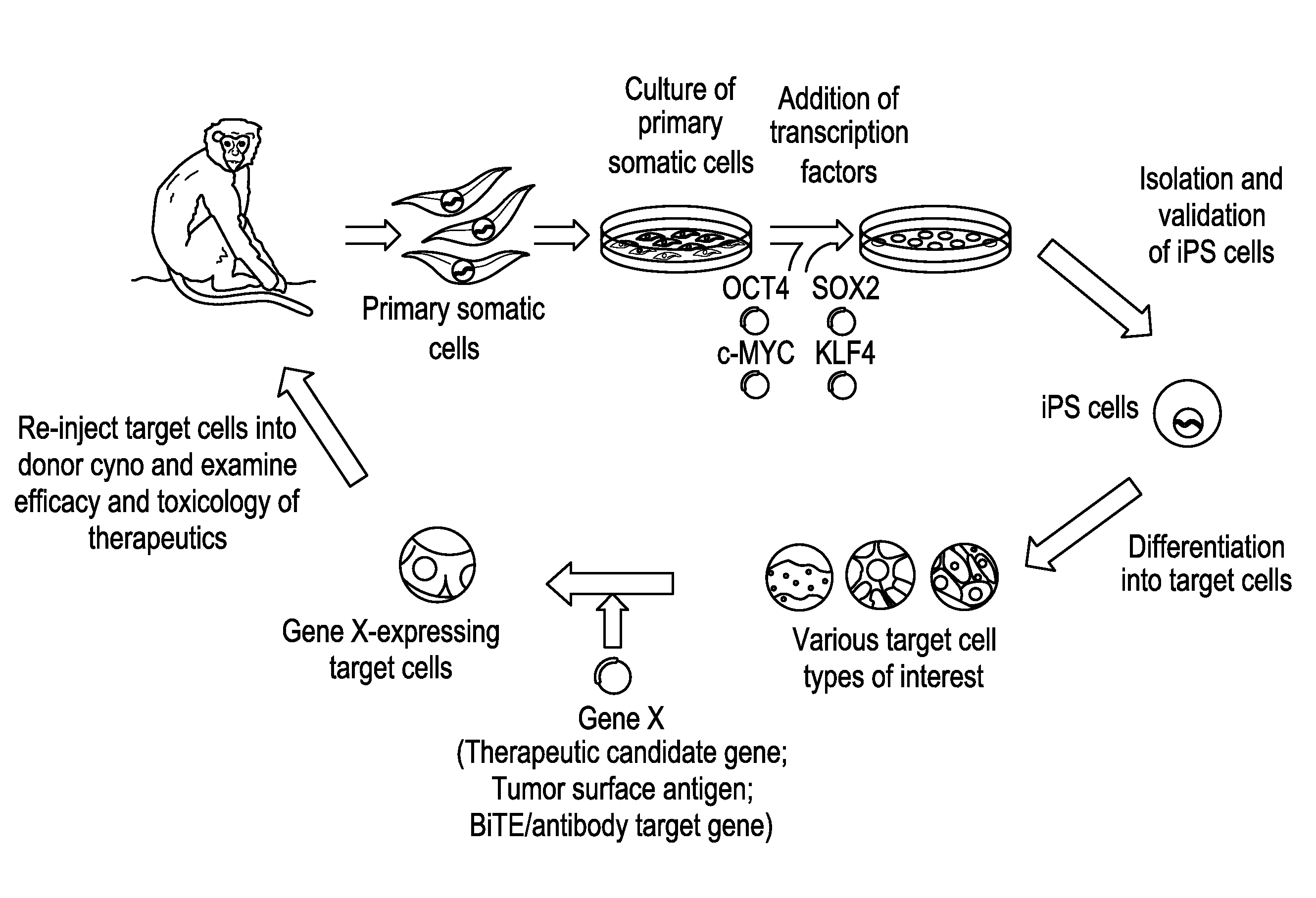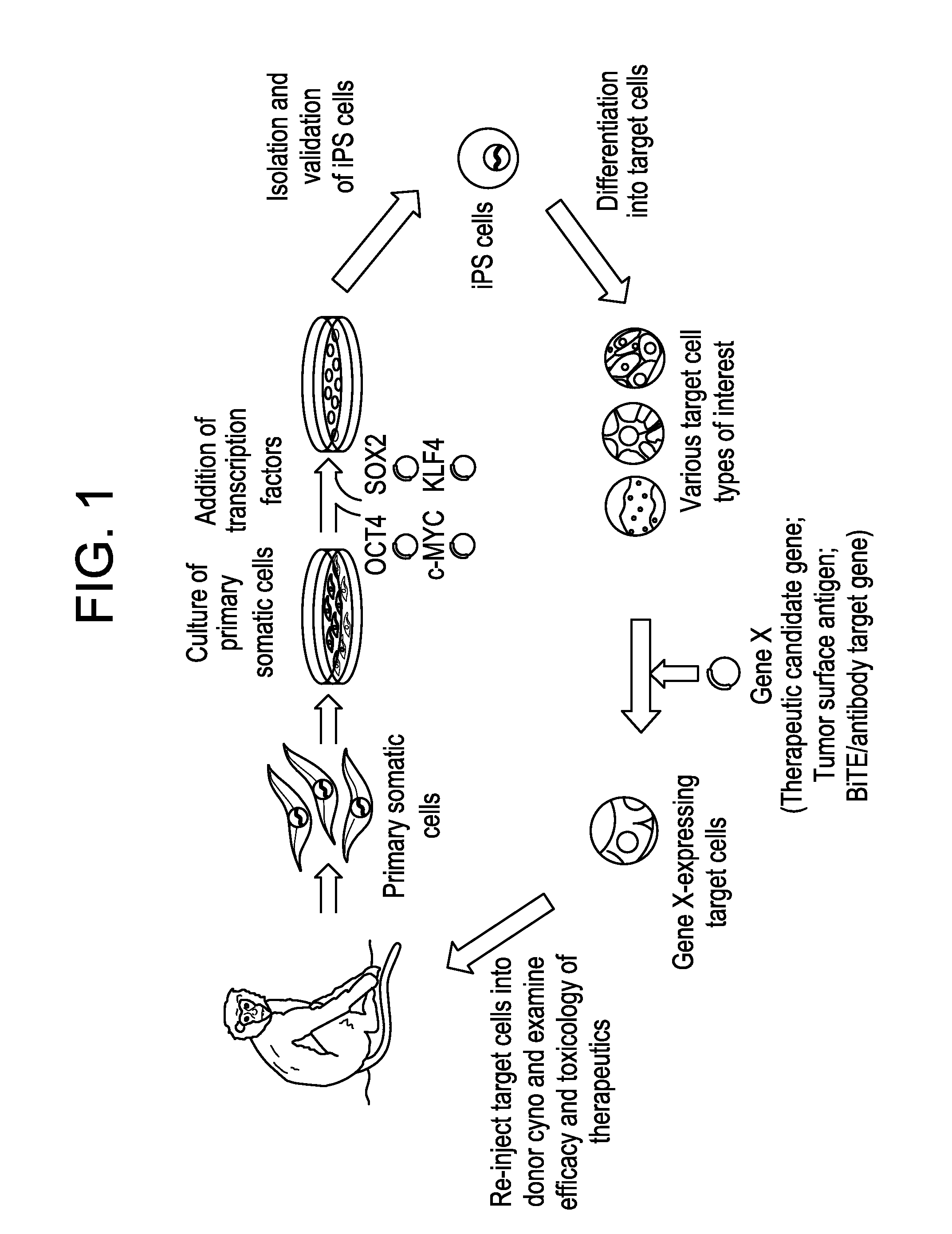Autologous Mammalian Models Derived from Induced Pluripotent Stem Cells and Related Methods
a technology of autologous mammalian models and stem cells, applied in the field of animal models of diseases, can solve the problems of comparatively little effort applied to the development of non-human primate (nhp) models in important diseases
- Summary
- Abstract
- Description
- Claims
- Application Information
AI Technical Summary
Benefits of technology
Problems solved by technology
Method used
Image
Examples
example 1
Materials and Methods
[0186]Fibroblast Cell Culture and Animals.
[0187]Skin biopsies were obtained from ten female Chinese cynomolgus macaques (˜3 years old; Charles River Laboratories, Reno, Nev.) and cynomolgus macaques (SNBL; Everett, Wash.). The cyno skin fibroblasts were isolated from dorsal skins of cyno monkeys and passaged multiple times (˜4 passages). The skin biopsies were minced with a sterile blade in DMEM, pH 7.4, containing 2 mg / ml collagenase IV (Invitrogen, #17104-019) in DMEM and 1 U / ml dispase (Invitrogen), and then were incubated at 37° C. for 2 hours. The skin cells were collected, filtered through the 70 μm strainer and washed. The resulting skin fibroblasts were cultured at 37° C. in DMEM, pH 7.4, containing 10% (v / v) fetal bovine serum (FBS), 2 mM L-glutamine, penicillin (100 IU / ml) and streptomycin (100 μg / ml).
[0188]Retrovirus Production and Transduction for Cyno iPS Cell Generation.
[0189]Separate retroviral vectors containing coding sequences for four human tr...
example 2
Generation of Autologous Non-Human Mammalian Models and Method of Monitoring Exogenously Introduced Cells
[0217]In order to generate an autologous non-human mammalian model, for example, in a non-human primate, we first generated cyno iPS cells by reprogramming cyno somatic cells, such as skin fibroblasts which can be easily obtainable from live animals. These differentiated adult somatic cells could be reprogrammed into a pluripotent state by ectopic expression of four human transcription factors, OCT4, SOX2, KLF4, and c-MYC (FIG. 2A-B).
[0218]Generation of Cyno iPS Cells.
[0219]The cyno fibroblasts were isolated and expanded from dorsal skins of female cyno monkeys (FIG. 3A). We examined the transduction efficiency of the retrovirus carrying these four factors in cyno skin fibroblasts. Retroviruses from two different backbone plasmids (pMX and pBMN) that are based on Moloney Murine Leukemia Virus (MMLV) were produced in PLAT-A packaging cells and yielded 20-50% transduction efficienc...
PUM
| Property | Measurement | Unit |
|---|---|---|
| Fraction | aaaaa | aaaaa |
| Fraction | aaaaa | aaaaa |
| Fraction | aaaaa | aaaaa |
Abstract
Description
Claims
Application Information
 Login to View More
Login to View More - R&D
- Intellectual Property
- Life Sciences
- Materials
- Tech Scout
- Unparalleled Data Quality
- Higher Quality Content
- 60% Fewer Hallucinations
Browse by: Latest US Patents, China's latest patents, Technical Efficacy Thesaurus, Application Domain, Technology Topic, Popular Technical Reports.
© 2025 PatSnap. All rights reserved.Legal|Privacy policy|Modern Slavery Act Transparency Statement|Sitemap|About US| Contact US: help@patsnap.com



